NorthEast Radio Watch 12/15/2025: NYC Morning Shakeup
In this week’s issue… NYC morning shows exit - Carton back amidst WFAN shakeup - FM signing off in Canada - More radio centennials
Text and photos by SCOTT FYBUSH
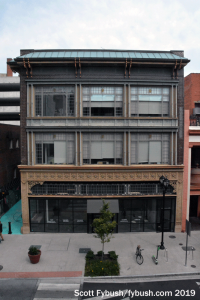
There are some cities with multiple public radio stations offering listeners a variety of formats. (Your editor is lucky enough not only to live in one of those cities, but to work for one of those stations.)
There are some cities where one operator runs, for instance, both a news-and-talk station and an all-classical station. (See above.)
There are others that have news, classical and some flavor of adult album alternative (AAA) – take, for instance, Philadelphia and its nice mix of news on WHYY, classical and jazz on WRTI and AAA on WXPN.
But there are very, very few where one operator has three full-time FM signals carrying each of those formats, all under a single roof. There’s St. Paul, where Minnesota Public Radio runs its multiple networks. There’s Iowa Public Radio’s fairly recent expansion into three formats.
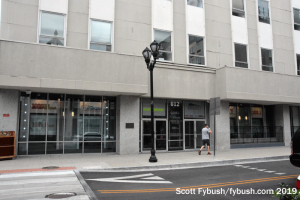
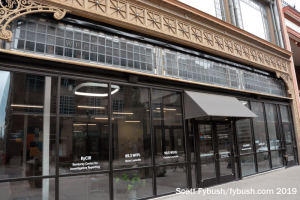
And there’s one of our favorites: Louisville Public Media in Kentucky’s biggest market, which for more than 25 years now has brought that city’s three public FM signals together under a single operating entity. It was a big deal back in 1993 when the “Public Radio Partnership” united the University of Louisville’s WUOL (90.5) with the two FM signals owned by Louisville’s Free Public Library, WFPL (89.3) and WFPK (91.9).
As with so many markets, these separate stations had evolved along somewhat parallel paths. WFPL was one of the oldest noncommercial FMs in the country, having started as a 10-watter back in 1950 (a year after the high school across the river in New Albany, Indiana put an even more pioneering 10-watter on the air, WNAS 88.1). WFPK joined it in 1954, playing classical music while WFPL did a wide variety of educational and cultural programming. There was a WFPK-TV, too, starting in 1958 on channel 15; it went independent from the city and the library in 1969 as WKPC, and eventually was merged in with the statewide Kentucky Public Television network. But yet again, we digress…
The university launched WUOL in 1976, adding a second classical format to the market. (Both WFPK and WUOL benefited, as did so much else in Louisville, from the charity of the Bingham family that owned the city’s newspapers; when they flipped the format of WHAS-FM from classical in 1975, they donated the record library to WFPK and equipment to WUOL.)
By the late 1980s, the library was looking to reduce its expenses in operating WFPK and WFPL,
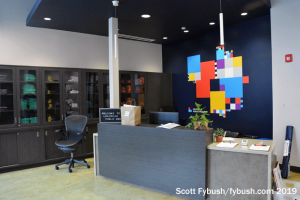

In 1993, the three stations came together operationally under the new PRP banner (changed to Louisville Public Media in 2008), though their studios remained separate. It took three years to realign the stations with a new set of formats: WUOL remained classical, WFPL sharpened its focus on news and talk – and WFPK became a pioneer in the AAA format as “Radio Louisville.”
The stations bought the former Louisville Electric Company building in 1997 and started making plans to renovate the three-story structure on South Fourth Street in the heart of downtown, only to be set back by a fire that gutted the building, followed by an outpouring of support from the city, generous donors and listeners.
By the end of 1999, the building was ready, the stations started moving in, and all was good for another 18 years. By 2017, it was time for a refresh, with new Wheatnet digital audio replacing older consoles and each of the studios getting new furniture and equipment – which meant they had that shiny new studio look when we dropped by on a warm afternoon in the summer of 2019.
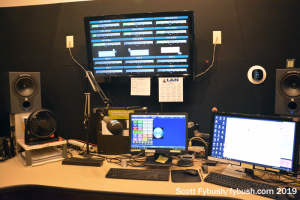
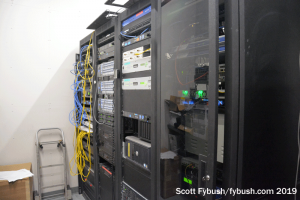
One more note before we head inside: LPM isn’t the only media operator on this block of South Fourth: directly across the street, Summit Media’s four FM stations (country WQNU 103.1, throwback R&B WRKA 103.9, AC WVEZ 106.9 and classic hits WSFR 107.7) have streetfront studios looking out at the sidewalk, though they were apparently all voicetracked when we walked by.
Over here at LPM, the lobby has an unusual feature: one wall is lined with glass cases showing off the wide variety of station swag on offer. (You can buy some of it online if you can’t make it to Louisville!)
Through the door, there’s a long hallway running the depth of the building, lined on the first floor by all the studios and technical core for the stations. Immediately to the left is the “Blinking Light Center” (there’s a sign, really!), where one studio functions as a master control room with monitoring of all three stations’ transmitters and streams, adjoining a rack room where the guts of the Wheatnet system lives.
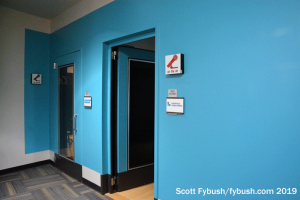
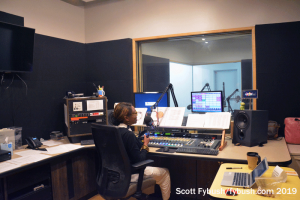
The graphic design here is remarkably consistent: the “L” logo of LPM is made up of three blocks representing each of the stations, and the colors of the blocks in the logo are carried into the studio hallway to mark off each set of studios.
WFPL’s air and production studios, plus its talk studio, sit up front behind the light blue doors; the talk studio gets the view right through the front windows to the lobby and the street.
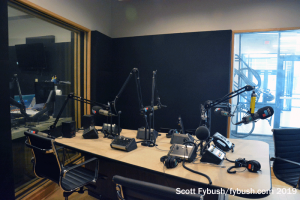
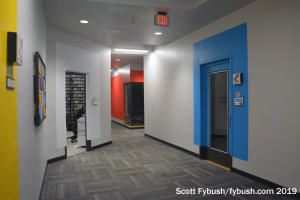
WUOL is the darker blue at the middle of the logo and the middle of the studio lineup; its air studio sits across the hallway from the record library that was reimagined during the renovation to become an airy space that also provides some music office space and serves as a green room for guests. WUOL has its own small performance space next to the air studio for chamber groups and such (and pledge drives, too!)
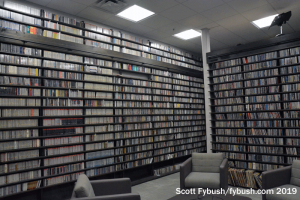
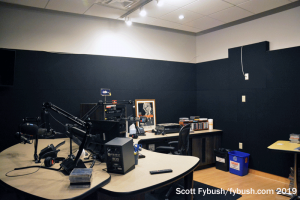
Toward the back of the hallway, with doors in red, is WFPK, whose studio is a little more decorated than the others, befitting the wide variety of music its DJs play. There’s enough room in this studio to bring in performers for smaller live music appearances, too.
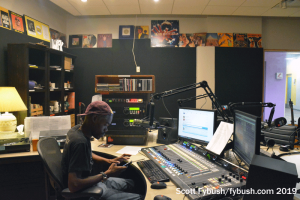
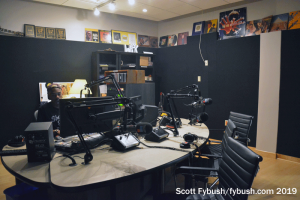
Bigger live groups get the big studio at the back of the building, a double-height space that’s largely unchanged from the original 1999 buildout. “Friday Live Lunch” is WFPK’s offering in here, complete with a live audience (well, it had one, anyway), while WUOL does “Lunchtime Classics”; the space is also regularly rented out for recording and rehearsal purposes.
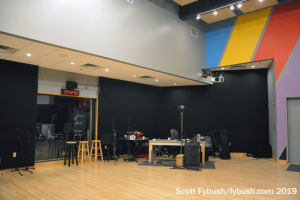
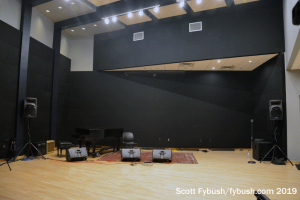
The control room for the performance space was refreshed in 2017, too, with a new Midas mixer, among other goodies.
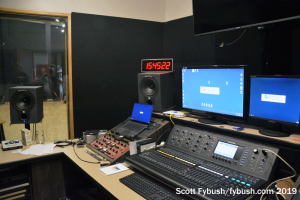
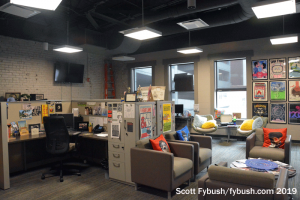
Upstairs, there are the usual business offices, of course – and as part of the renovation, a hugely expanded newsroom that takes up much of the top floor, with its own small row of studios for interviews and voice work.
In addition to the original three radio stations, there are two more legs to LPM these days: the newsroom not only feeds WFPL but is also home to the Kentucky Center for Investigative Reporting (KyCIR), which does its own deep reporting on matters of public interest that are getting ignored by other media.
LPM also added an events website, Do502.com, a separate commercial entity that runs somewhat independently of the rest of LPM.

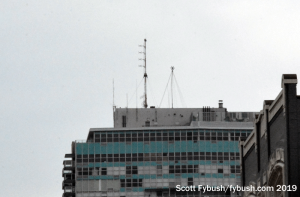
WFPK has its music and programming offices at the back of the building up here, too – and at least for now, that wraps up our tour of this very impressive content factory that’s churning out so much good radio, podcasting and digital media.
But before we leave downtown Louisville and head 90 minutes away back into Indiana, there’s one more bit of local radio history just a couple of blocks south on 4th Street: the apartment tower at 800 S. 4th, once the tallest building in town, has long been crowned by the antenna for what’s now WXMA (102.3), Alpha Media’s “Jack FM.”
Ask any Louisville old-timer, though, and they’ll remember the 102.3 frequency not as “Jack” but as WLRS, the pioneering independent progressive FM station owned by Clarence Henson’s Louisville Radio School. There’s a whole story to be told about Henson’s importance in the Louisville broadcast community – and about his son, Ed, who’s still a prominent station owner and broker – but that’s for another Louisville trip, and here’s hoping we get to take one soon.
Thanks to LPM’s Russell Wells for the tours!
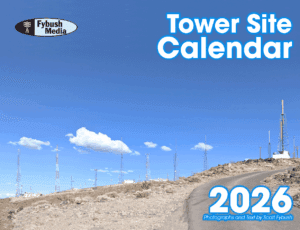
As we announced a few weeks ago, the 2026 edition of the Tower Site Calendar will be the last.
We began publishing it 25 years ago, and the broadcast landscape is radically different now.
Radio World just ran an excellent article about us if you want to know more.
Once it’s gone, that’s it. We won’t be printing any more.
Thank you to everyone who saw our announcement and rushed to buy it. We appreciate you.
(There are some calendars from previous years if you want more of a tower photo fix — all under $5.)
But don’t wait to get this year’s Tower Site Calendar — buy it now!
We are selling the Broadcast Historian’s Calendar again this year, but we have that in an even smaller quantity — definitely don’t hesitate for that.
And visit the Fybush Media Store to check out our selection of books and videos, too!
And don’t miss a big batch of Louisville IDs next Wednesday, over at our sister site, TopHour.com!
Next week: French Lick, Indiana at dusk
In this week’s issue… NYC morning shows exit - Carton back amidst WFAN shakeup - FM signing off in Canada - More radio centennials
In this week’s issue… Veteran newsman returns - Remembering NY's Leitner, RI's Jones - CT AM saved - Maine AM moves - "Indie" adds suburban signals
In this week’s issue… Scripps stations face takeover - Sinclair moves more affiliations - CT stations sold - Maine AM surrendered - Remembering WVBR's Shapiro, WABC's Morgan
In this week’s issue… CT TV legend succumbs to cancer - Remembering PA's Adams - FCC still stalled by shutdown - Pittsburgh morning host exits